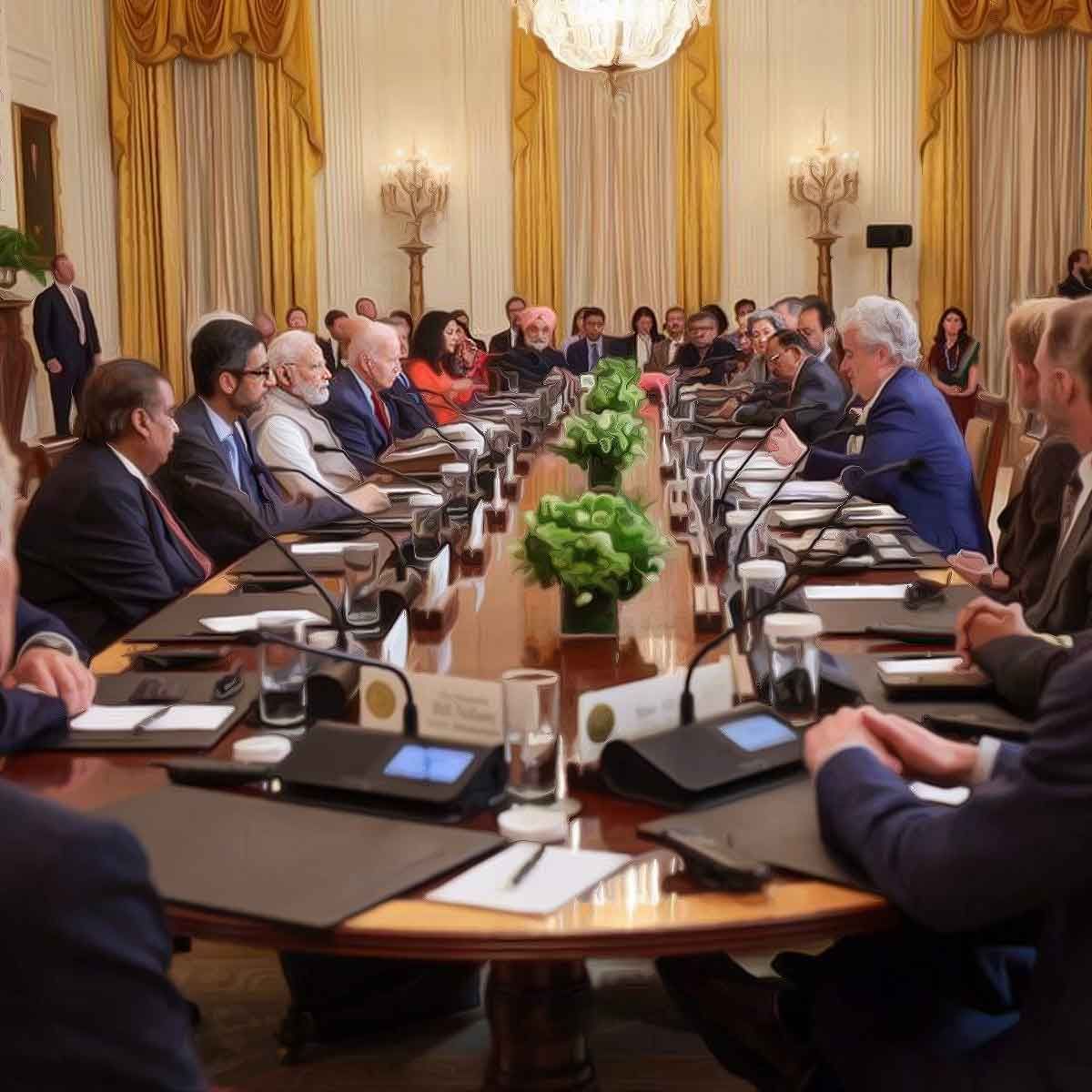MORE COVERAGE
Twitter Coverage
Satyaagrah
Written on
Satyaagrah
Written on
Satyaagrah
Written on
Satyaagrah
Written on
Satyaagrah
Written on
JOIN SATYAAGRAH SOCIAL MEDIA
Semiconductor Titans, Micron, Applied Materials, and Lam forging robust alliances with India, unveiling monumental billion-dollar investments to significantly bolster India's Semiconductor Mission and usher a future of unprecedented tech advancements

In a groundbreaking development signifying a vibrant era of synergistic innovation, premier American semiconductor corporations have unveiled substantial investment plans. These financial commitments are designed to turbocharge the advancement of India's Semiconductor Mission (ISM), lending the mission an impressive momentum.
|
This auspicious announcement was made in the context of Prime Minister Narendra Modi's visit to the United States, lending it a distinct hue of international cooperation and high-level diplomacy.
The White House, highlighting the critical nature of this initiative, has earmarked the reinforcement of semiconductor supply chains as the pinnacle priority. This declaration was made during the unveiling of the 'technology partnership for the future', a visionary framework guiding the technological collaboration between the two nations. This follows the constructive dialogue held between PM Modi and US President Joe Biden in Washington, which set the stage for a stronger bilateral relationship.
The announcement echoes the strategic objectives defined in the Memorandum of Understanding (MoU), an instrumental document formalizing the mutual commitment to innovation. The MoU was signed by US Secretary of Commerce Gina Raimondo and India’s Minister of Commerce and Industry Piyush Goyal. The signing took place during the India-US Commercial Dialogue, a momentous event held in New Delhi on March 10, highlighting the growing bonds of collaboration between the two nations.
The objective of the agreement is to orchestrate a dynamic collaborative mechanism between the two national governments, emphasizing the resilience and diversification of the semiconductor supply chain. This mechanism takes into account the regulatory frameworks of both nations, including the US’s CHIPS and Science Act and India’s ambitious Semiconductor Mission. This represents an astute blend of policy and practice, guided by the mutual goals of technological growth and industrial resilience.
The importance of semiconductors in today's interconnected world cannot be overstated. They form the bedrock of electronic devices, serving as the invisible engines driving breakthroughs across multiple sectors. They power advancements in critical domains such as communications, computing, healthcare, military systems, transportation, clean energy, and a plethora of other applications. By bolstering the supply chains and collaborative mechanisms, both nations are nurturing an ecosystem that enables technological growth, industry innovation, and sustainable progress.
|
In a landmark announcement made earlier today, Micron Technology, one of the foremost global manufacturers of semiconductor chips, declared plans to channel over $800 million into the development of an expansive $2.75 billion semiconductor assembly and test facility, with its location pinpointed in Gujarat, India.
This grand project, conceived to fortify the company's position in the industry and to cater to escalating demand, is divided into several phases. The first phase, to kick off within this year, encompasses the erection of a substantial cleanroom facility spanning a colossal 500,000 square feet. The project's timeline sets the inaugural operationalization of this phase for the latter part of 2024. Micron delineated its strategy to progressively amplify the facility's capacity over an extended period, aligning this expansion trajectory with global demand patterns. Looking towards the latter half of the decade, Micron anticipates initiating Phase 2. This phase is intended to mirror the magnitude of Phase 1, thereby substantiating the company's commitment to continuous growth.
Micron's upcoming facility is ingeniously engineered to accommodate the assembly and testing procedures for both Dynamic Random Access Memory (DRAM) and NAND products. It signifies the company's response to the booming demand surfacing from both domestic Indian and international markets, and is a manifestation of their strategic planning.
|
As per the financial outline, the Indian government has pledged to bear 50% of the total project expenditure. Additionally, the state of Gujarat has offered incentives amounting to 20% of the project's total cost. In aggregate, the joint investment by Micron and the two government entities across both project phases is estimated to reach a staggering $2.75 billion.
In a statement, Micron's President and CEO Sanjay Mehrotra expressed his enthusiasm about the venture, “We are excited about the steps India is taking to develop the local semiconductor ecosystem… Our new assembly and test location in India will enable Micron to expand our global manufacturing base and better serve our customers in India and around the world.” Mehrotra met with Prime Minister Narendra Modi in Washington on June 21 to discuss this significant development.
The new facility will not only augment Micron's capabilities, but it also introduces transformative potential to the semiconductor sector by focusing on converting silicon wafers into ball grid array (BGA) integrated circuit packages, memory modules, and state-of-the-art solid-state drives.
Commenting on the development, Minister for Railways, Communications, Electronics, and IT Ashwini Vaishnaw articulated, “Micron’s investment to set up assembly and test manufacturing in India will fundamentally transform India’s semiconductor landscape and generate tens of thousands of high-tech and construction jobs.” This emphasizes the far-reaching impacts of the project, underscoring its potential to revolutionize the country's semiconductor sector and provide abundant job opportunities in high-tech and construction fields.
|
Situated at the heart of California's Silicon Valley, Applied Materials, a pioneering entity recognized for its expertise in materials engineering solutions that contribute to the creation of virtually every new chip and advanced display worldwide, has recently unveiled its ambitious plan to establish a collaborative engineering center in Bengaluru, India.
This proposed center is envisioned as a vibrant hub of collaboration, bringing together Applied Materials' engineers, a host of premier global and domestic suppliers, and illustrious research and academic institutions under one roof. This synergistic setup aims to expedite the progression of semiconductor equipment sub-systems and components development.
Furthermore, the center aspires to act as a significant catalyst for nurturing future talent in the semiconductor industry. It also seeks to unlock unprecedented opportunities for India to assume a more influential role in the global semiconductor landscape.
Expressing his enthusiasm about the new development, Prabu Raja, President of the Semiconductor Products Group at Applied Materials, stated, “Applied is excited to build upon our 20 years of success in India by creating a facility where the country’s top engineers, suppliers, and researchers can work side-by-side to develop new innovations.”
|
The company has committed a sizeable gross investment of $400 million, spread across a span of four years, to realize the new center in India. The facility is projected to bolster over $2 billion of planned investments within its first half-decade of operation. Additionally, it is expected to generate at least 500 new advanced engineering jobs, and potentially even spur the creation of 2,500 jobs within the manufacturing ecosystem.
Raja further added, “We envision Applied’s strong base of engineering talent collaborating more deeply with domestic and global companies operating in India to strengthen the foundational equipment supply chain serving the global semiconductor manufacturing industry.”
Parallelly, Fremont-based Lam Research Corporation, a renowned global supplier delivering innovative wafer fabrication equipment and services to the semiconductor industry, announced last Friday its commitment to cultivate the forthcoming generation of semiconductor engineers in India.
The company's initiative is devised to instruct up to 60,000 Indian engineers in nanotechnologies over a course of ten years. This strategy aligns with India’s overarching goals for semiconductor education and workforce development. Lam recognizes its Semiverse Solutions portfolio as a groundbreaking game-changer, offering a fundamental platform to shape a virtual semiconductor innovation universe, especially when the semiconductor industry grapples with a significant talent deficit in the face of projected future demand.
|
Lam Research President and CEO Tim Archer said, “The role semiconductors play in enabling everything from artificial intelligence to electric vehicles is fueling a greater need for nanotechnology expertise around the world. We look forward to working with the government of India in support of their goal to fast-track the education and training of the next generation of semiconductor engineers.”
Additionally, the US Semiconductor Industry Association and the India Electronics Semiconductor Association (IESA) jointly published an interim readiness assessment. This evaluation aims to discern near-term industry opportunities and facilitate the long-term strategic growth of compatible semiconductor ecosystems.
India's focus remains steadfast on its critical objective of bolstering the country's semiconductor scenario and ensuring it acts as a catalyst for the nation's burgeoning electronics manufacturing and innovation ecosystem. Under the leadership of PM Modi, the Indian government has sanctioned the Semicon India programme, with an allocation of Rs 76,000 crore earmarked for the advancement of the semiconductor and display manufacturing ecosystem in the country. The program has been further adapted considering the aggressive incentives offered by nations with established semiconductor ecosystems and the limited number of companies that possess advanced node technologies.
 Support Us
Support Us
Satyagraha was born from the heart of our land, with an undying aim to unveil the true essence of Bharat. It seeks to illuminate the hidden tales of our valiant freedom fighters and the rich chronicles that haven't yet sung their complete melody in the mainstream.
While platforms like NDTV and 'The Wire' effortlessly garner funds under the banner of safeguarding democracy, we at Satyagraha walk a different path. Our strength and resonance come from you. In this journey to weave a stronger Bharat, every little contribution amplifies our voice. Let's come together, contribute as you can, and champion the true spirit of our nation.
 |  |  |
| ICICI Bank of Satyaagrah | Razorpay Bank of Satyaagrah | PayPal Bank of Satyaagrah - For International Payments |
If all above doesn't work, then try the LINK below:
Please share the article on other platforms
DISCLAIMER: The author is solely responsible for the views expressed in this article. The author carries the responsibility for citing and/or licensing of images utilized within the text. The website also frequently uses non-commercial images for representational purposes only in line with the article. We are not responsible for the authenticity of such images. If some images have a copyright issue, we request the person/entity to contact us at This email address is being protected from spambots. You need JavaScript enabled to view it. and we will take the necessary actions to resolve the issue.
Related Articles
- “He who has a Why to live can bear almost any How”: A Triumph for Cultural Heritage as PM Modi while addressing the Indian diaspora at the Ronald Reagan Center in Washington DC announced that the US will return over 100 stolen Antiquities to India
- In yet another milestone of BJP, Indian Railways First-Ever Freight Train Reaches ‘Rani Gaidinliu Railway Station’ marking a major breakthrough for railway authorities: Manipur
- Piyush Goyal claimed that Indian Textile Industry has potential to achieve $100 Billion in exports by 2030: Says new agreements with Australia and UAE open infinite opportunities for Indian industries
- Modi govt announces incentive scheme for RuPay and BHIM-UPI after Visa complained to US govt about Indian govt promoting RuPay
- Terrorism, Pakistan, COVID, Afghanistan and more: Here’s all that PM Modi and US VP Kamala Harris discussed in the bilateral meet
- Highest annual Foreign Direct Investment inflow of USD 83.57 billion recorded by India in FY21-22, IT sector bags the largest share: proves that India is growing as a desirable destination for international investment
- "Global trust, local talent: India's invitation to the semiconductor world": PM Modi announces that India's moment has arrived in the semiconductor, Global leaders unite in praise as India gets ready to take center stage in the semiconductor industry
- "Experience the majestic 'Yashobhoomi', an emblem of India's advancements in global conventions and expos, developed with a budget of Rs. 5400 crore, it encompasses 73,000 sqm, featuring 15 convention rooms with the capacity to host 11,000 delegates
- "In unity there is strength; in partnership, there's power": India-UAE economic alliance marks turning point in their shared history, CEPA to boost trade, stimulate investments & fortify economies, advancing both nations towards mutual growth & prosperity
- Anthony Blinken delusional about US primacy over world affairs made schoolmasterish remarks, “US monitoring human rights abuses in India”: Lutyens elites and the editors of India’s English-language media outlets lap it up
- "True art awakens the Extraordinary Ovation": 15 standing ovations, 79 applauses, autographs, selfies, and the whole house echoing with ‘Modi Modi slogans, Prime Minister Modi's joint address to the US Congress resonated as a resounding success
- "In the market's good mood, fortunes are made and dreams are realized": Indian Tractor Sales soar to Unprecedented Heights by hitting all-time-high record of 9.44 lakh units in FY23, up 12% compared to last year, Brands achieve record-breaking figures
- "Respect is earned. Honesty is appreciated. Trust is gained": A Melody of Respect: American Singer Mary Millben sings the soulful rendition of the Indian National Anthem in a Heartfelt homage to India, touches the feet of Prime Minister Modi at Washington
- "New dynamism in ties": In Jakarta, PM Modi calls for a new rules-based order in the post-Covid era, emphasizing the critical role of the ASEAN-India partnership in shaping the resurgence of Asia in the 21st century and fostering global growth
- "When a warMonger lectures about peace, you know hypocrisy has found its poster child": Obama, the 'Nobel Peace Prize' laureate with a track record of 'peaceful drone strikes', architect of Middle East chaos lectures our Modi on human rights. That's rich!

























